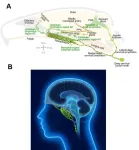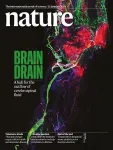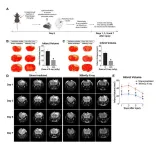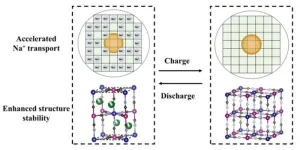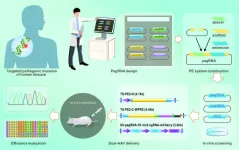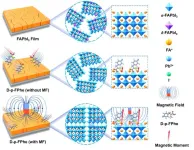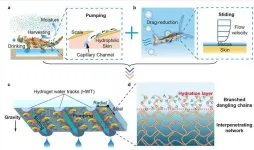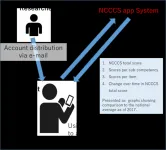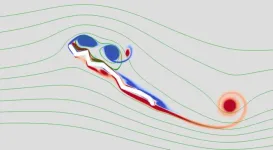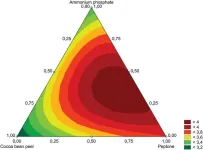Brain drain - nasopharyngeal lymphatics found to be crucial for cerebrospinal fluid outflow
‘Lymphatic plexus’ behind the nose drains cerebrospinal fluid from the brain, potentially impacting neurodegenerative conditions
2024-01-26
(Press-News.org)
In a groundbreaking study published in Nature, South Korean researchers led by Director KOH Gou Young of the Center for Vascular Research within the Institute for Basic Science (IBS) have uncovered a distinctive network of lymphatic vessels at the back of the nose that plays a critical role in draining cerebrospinal fluid (CSF) from the brain. The study, sheds light on a previously unknown route for CSF outflow, potentially unlocking new avenues for understanding and treating neurodegenerative conditions.
In our brains, waste products generated as byproducts of metabolic activity are expelled through cerebrospinal fluid (CSF). Accumulation of waste in the brain, if not properly expelled, can damage nerve cells, leading to impaired cognitive function, dementia, and other neurodegenerative brain disorders. Hence, the regulation of CSF production, circulation, and drainage has long been a focus of scientific attention, especially in relation to age-related conditions like Alzheimer's disease and other neurodegenerative diseases.
The brain produces around 500 mL of this fluid per day, which is drained from the subarachnoid space. Among the known drainage routes are lymphatic vessels around the cranial nerves and the upper region of the nasal cavity. Despite well-documented evidence of lymphatics aiding CSF clearance, identifying the exact anatomical connections between the subarachnoid space and extracranial lymphatics has posed a challenge due to their extremely complex structure.
Koh’s team tackled this problem using transgenic mice with lymphatic fluorescent markers, microsurgeries, and advanced imaging techniques. Their efforts revealed a detailed network of lymphatic vessels at the back of the nose that serves as a major hub for CSF outflow to deep cervical lymph nodes in the neck. These lymphatics were found to have distinct features, including unusually shaped valves and short lymphangions.
Lead researcher JIN Hokyung highlighted, "Our study identified the nasopharyngeal lymphatic plexus as a hub for CSF outflow. CSF from specific cranial regions drained through these lymphatics to deep cervical lymph nodes in the neck. This discovery could have significant implications for understanding and treating conditions related to impaired CSF drainage."
The study also demonstrated that pharmacological activation of the deep cervical lymphatics enhanced CSF drainage in mice. The researchers were able to successfully modulate cervical lymphatics using phenylephrine (which activates α1-adrenergic receptors, causing smooth-muscle contraction) or sodium nitroprusside (which releases nitric oxide, inducing muscle relaxation and vessel dilation). Importantly, this feature was preserved during aging, even when the nasopharyngeal lymphatic plexus had shrunk and was functionally impaired.
YOON Jin-Hui, the co-first author of this study, notes, “The deep cervical lymphatics, which remain intact with aging, offer a potential target for therapeutic interventions aimed at improving CSF outflow in individuals with compromised brain health.”
This endeavor was not without its own challenges, however. Deep anesthesia and removal of neck musculature were required to expose the lymphatics in the mice. These delicate procedures themselves had problems altering the physiological dynamics of CSF drainage because cerebral blood flow and blood pulsing through the vasculature contribute to CSF circulation, which in turn influences CSF outflow. Also, while the imaging techniques used were informative, researchers believe more advanced methods for imaging live animals (such as synchrotron X-ray imaging) may reveal more features of the dynamics of CSF drainage under physiological conditions.
Director KOH Gou Young of the Center for Vascular Research stated, “We plan to verify all the findings from the mice in primates, including monkeys and humans. We aim to investigate in a reliable animal model whether activating the cervical lymphatic vessels through pharmacological or mechanical means can prevent the exacerbation of Alzheimer’s disease progression by improving CSF clearance.”
The results of this research have been published online on January 11th in the journal Nature (IF 69.504). It also has been published in print in the January 25th issue of Nature, featured as a cover titled “BRAIN DRAIN”.
END
ELSE PRESS RELEASES FROM THIS DATE:
2024-01-26
Traumatic brain injury (TBI) and ischemic stroke are major public health concerns and leading causes of death and disability worldwide. A research team led by City University of Hong Kong (CityU) neuroscientists recently discovered that low-dose ionizing radiation (LDIR), such as X-ray irradiation, can reduce lesion size and reverse motor deficits in TBI and ischemic stroke mice, demonstrating that LDIR may be a promising therapeutic strategy for TBI and stroke patients.
Nearly half of TBI and stroke survivors experience lifelong motor impairment and disability. “Usually, secondary brain damage worsens over time after primary ...
2024-01-26
Patients with muscle-invasive urothelial cancer and a high risk of recurrence after surgery may have a new treatment option. The Alliance for Clinical Trials in Oncology today announced positive results from the phase III AMBASSADOR (A031501) trial for the adjuvant treatment of patients with localized muscle-invasive urothelial carcinoma (MIUC) and locally advanced urothelial carcinoma. Late-breaking data from the trial are being presented during an oral abstract session at the 2024 American Society of Clinical ...
2024-01-26
Waltham — January 25, 2024 — A newly developed neural network is highly accurate in identifying key landmarks important in breast surgery – opening the potential for objective assessment of breast symmetry, suggests a study in the February issue of Plastic and Reconstructive Surgery®, the official medical journal of the American Society of Plastic Surgeons (ASPS). The journal is published in the Lippincott portfolio by Wolters Kluwer.
"Neural networks and machine learning have the potential to improve evaluation of breast symmetry in reconstructive ...
2024-01-26
This study is led by Prof. Yuliang Cao and Prof. Yongjin Fang (College of Chemistry and Molecular Sciences, Wuhan University). The experiments were performed by using ammonia etching on highly crystalline Na2NiFe(CN)6 (denoted as NaNiHCF) to activate the sodium storage sites and accelerate the Na+ transport.
Fe(CN)6 vacancies and the water molecules in the lattice, which are concomitant during the synthesis, however, lead to poor electrochemical performance. Hence, optimizing the crystal structures of PBAs to boost their electrochemical performance is currently a hot spot in the research ...
2024-01-26
This study is led by Prof. Xianqun Fan (Department of Ophthalmology, Shanghai Jiao Tong University School of Medicine Affiliated Ninth People’s Hospital).
Gene editing ushers in a new era of disease treatment since many genetic diseases are caused by base-pair mutations in genomic DNA. With the rapid development of genome editing technology, novel editing tools such as base editing and prime editing have attracted public attention, heralding a great leap forward in this field.
Prime editing (PE) was proposed by David Liu’s team in 2019, which is characterized ...
2024-01-26
In the realm of clean energy, metal halide perovskite solar cells (PSCs) have emerged as a groundbreaking focus, capturing significant attention for their extraordinary advancements. In just over a decade, their certified power conversion efficiency (PCE) has skyrocketed to 26.1%, approaching the upper limits seen in traditional crystalline silicon cells. What sets PSCs apart is their potential to surpass the 30% PCE threshold [1].
The key to optimizing solar devices lies in the deposition of high-quality perovskite films. Achieving minimal defect density and exceptional homogeneity becomes crucial for enhancing device performance. One commonly employed strategy involves introducing ...
2024-01-26
This study, led by Prof. Jiuhui Qu, Dr. Qinghua Ji, and Dr. Wei Zhang from Tsinghua University, focuses on addressing water scarcity by exploring atmospheric water harvesting. The water in the air originates from both natural and forced evaporation, with condensation being the final and crucial step in water harvesting. Condensation involves nucleation, growth, and shedding of water droplets, which are then collected. However, uncontrollable growth of condensed droplets leading to surface flooding is a pressing challenge due to insufficient driving forces, posing a threat to sustainable condensation.
To expedite this process and achieve orderly ...
2024-01-26
To improve the care coordination competency of nurses involved in the management of critically ill patients on life support, an electronic app—NCCCS—was developed by Associate Professor Chie Takiguchi of Toho University and Professor Tomoko Inoue of International University of Health and Welfare.
The NCCCS app utilizes the scoring system referred to as the Nurses' Care Coordinate Competency Scale (NCCCS), developed by Dr. Takiguchi et al. in 2017, and it is currently being translated into Chinese, Italian, Polish, and Persian. This app offers immediate feedback to nurses caring for critically ill patients on life ...
2024-01-26
Scientists from Hiroshima University undertook a study of dragonfly wings in order to better understand the relationship between a corrugated wing structure and vortex motions. They discovered that corrugated wings exhibit larger lift than flat wings.
Their work was published in the journal Physical Review Fluids on December 7, 2023.
The researchers set out to determine if the corrugation of a dragonfly's wing is a secret ingredient for boosting lift. While past research has largely zoomed in ...
2024-01-26
Amylases are among the most important biotechnological and industrial enzymes that can be applied in various sectors, such as food, pharmaceuticals, textiles, chemicals, paper, and detergents.
The enzymes’ costs come from a range of factors including the quantity produced, the production process, the expense of its recovery, and the degree of purity at which it will be marketed, etc. The use of agro-industrial substrates and microorganisms brings the potential to low-cost enzyme production. Meanwhile, due to the ability to improve physical and chemical resistance to industrial environmental extremes, such as high temperature and pH, as well ...
LAST 30 PRESS RELEASES:
[Press-News.org] Brain drain - nasopharyngeal lymphatics found to be crucial for cerebrospinal fluid outflow
‘Lymphatic plexus’ behind the nose drains cerebrospinal fluid from the brain, potentially impacting neurodegenerative conditions
